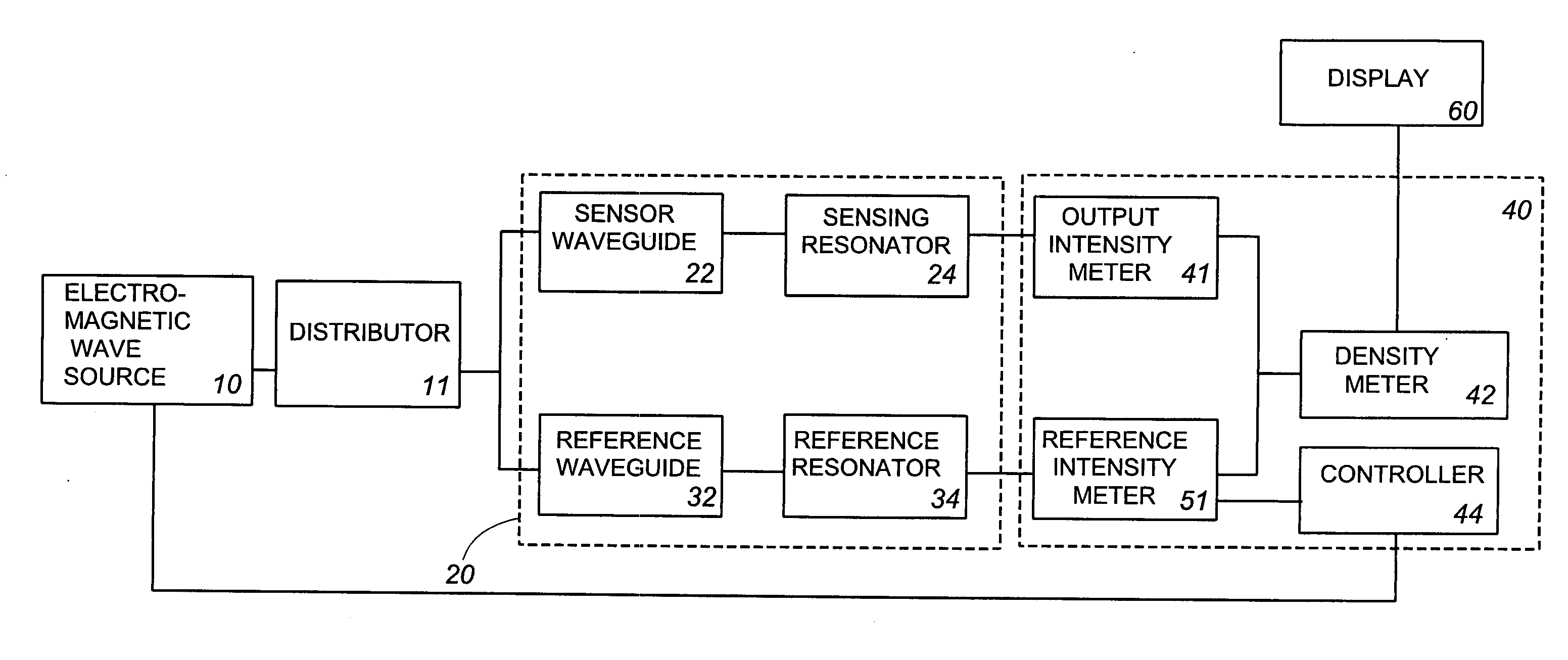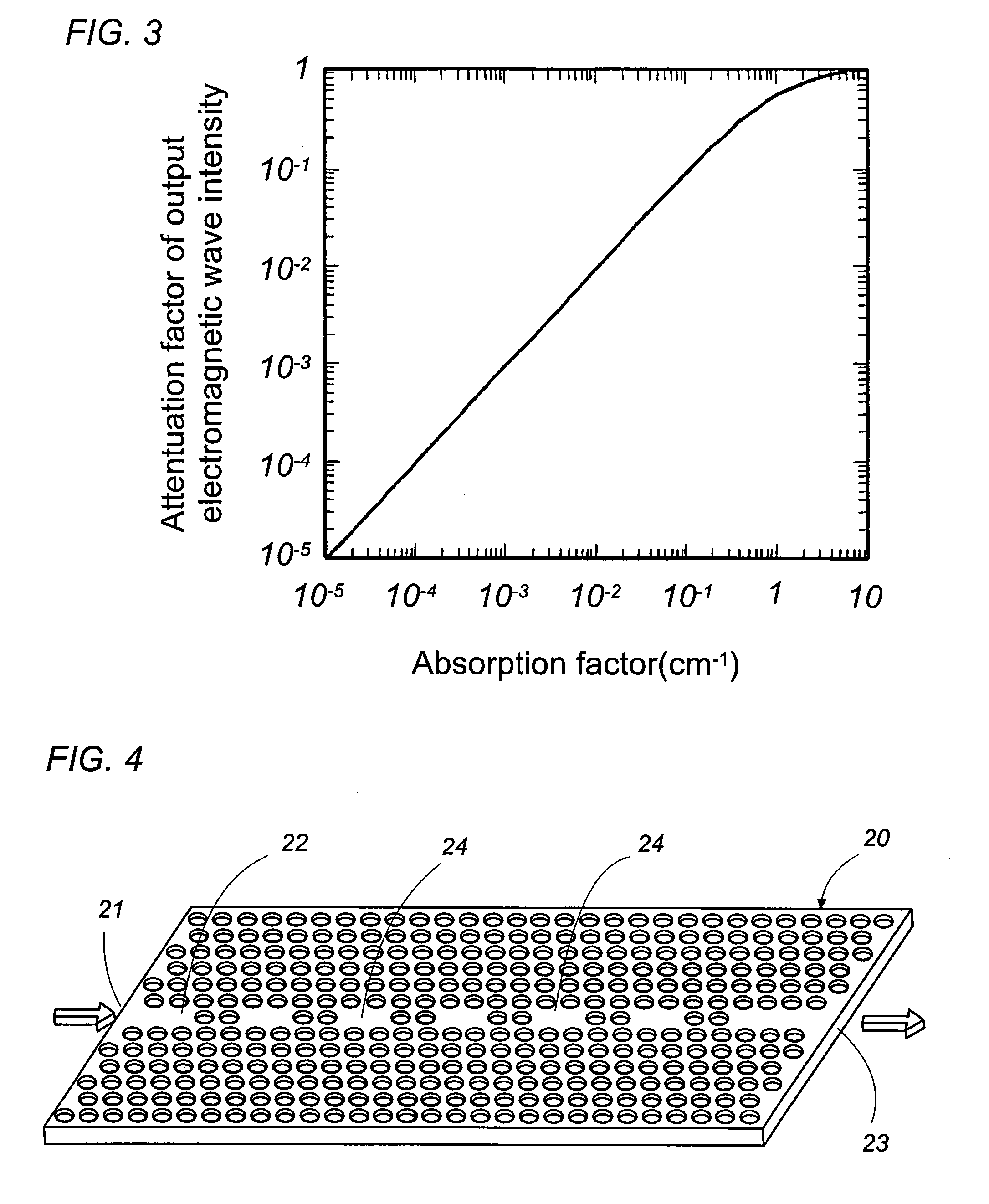Target Substance Sensor and Method Thereof Using a Photonic Crystal
a target substance and photonic crystal technology, applied in the direction of optical radiation measurement, instruments, spectrometry/spectrophotometry/monochromators, etc., can solve the problems of reducing the sensitivity and failing to make accurate density measurement, and achieve high-sensitivity density detection, enhance the effect of the drop efficiency of the electromagnetic wave and accurate measurement in compensation
- Summary
- Abstract
- Description
- Claims
- Application Information
AI Technical Summary
Benefits of technology
Problems solved by technology
Method used
Image
Examples
1st embodiment
[0064]In the present embodiment, the electromagnetic wave of the specific wavelength that the target substance absorbs is caused to resonate at the resonator so as to detect the target substance based upon an attenuation factor of the output from the resonator. The applicable target substance includes that has a prominent character of absorbing the electromagnetic wave of the specific wavelength, for example, carbonic acid gas and nitrogen gas, and the like gas.
[0065]FIGS. 1 and 2 illustrates the sensor in accordance with the present embodiment in which the photonic sensor element 20 is formed with a senor waveguide 22 and a reference waveguide 32 which introduce the electromagnetic waves including that having the specific wavelength, for example, an infrared ray having a wavelength of 2 μm to 13 μm, as well as a sensing resonator 24 and a reference resonator 34 which are electromagnetically coupled respectively to the waveguides. The resonators are each configured to resonate the e...
2nd embodiment
[0079]FIG. 9 illustrates a second embodiment of the present invention in which the photonic sensor element 20 is configured to supply the electromagnetic wave from the source 10 to the sensing resonator 24 and the reference resonator 34 through a single input port 21. The photonic sensor element 20 is formed with a first photonic crystalline structure PC1 and a second photonic crystalline structure PC2 which are of different crystalline structures from each other. That is, the two different crystalline structures have minute circular pores of altering the refractive index which are arranged at different cycles within the two-dimensional array to selectively propagate the electromagnetic wave of different wavelengths. The sensor waveguide includes an input waveguide 22A extending over the two crystalline structures PC1 and PC2, and two output waveguides 22B1 and 22B2 belonging to each of the crystalline structures. The sensing resonator 24 and the reference resonator 34 are respectiv...
3rd embodiment
[0081]FIGS. 10 and 11 illustrates an embodiment discloses a scheme realized for measurement of the target substance which has a prominent character of altering the refractive index of the atmosphere. The target substance includes, for example, a steam and alcohol. The density measurement of the target substance is made by making the use of the phenomenon that the wavelength that resonates at the sensing resonator will shift in response to the alternation of the refractive index around the sensing resonator caused by the presence of the target substance. FIG. 12 indicates a relation between the refractive index of the target substance and the corresponding wavelength of the electromagnetic wave resonating at the resonator. Thus, by designing the sensing resonator to resonate at the specific wavelength determined by the target substance, the density of the target substance can be regarded as a function of the output intensity emitted from the sensing electrode 24.
[0082]For this purpos...
PUM
| Property | Measurement | Unit |
|---|---|---|
| thickness | aaaaa | aaaaa |
| thickness | aaaaa | aaaaa |
| refractive index | aaaaa | aaaaa |
Abstract
Description
Claims
Application Information
 Login to View More
Login to View More - R&D
- Intellectual Property
- Life Sciences
- Materials
- Tech Scout
- Unparalleled Data Quality
- Higher Quality Content
- 60% Fewer Hallucinations
Browse by: Latest US Patents, China's latest patents, Technical Efficacy Thesaurus, Application Domain, Technology Topic, Popular Technical Reports.
© 2025 PatSnap. All rights reserved.Legal|Privacy policy|Modern Slavery Act Transparency Statement|Sitemap|About US| Contact US: help@patsnap.com



